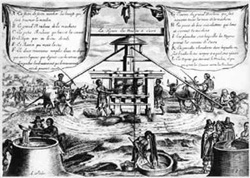
|
|
Sugar machine - Haïti ©Bibliothèque des Pères du Saint-Esprit |
Haiti experienced three centuries of slavery and is one of the few countries where action led not only to its abolition but also to territorial independence. In the light of that outstanding achievement, Haiti featured in the wave of major transformations that, in the nineteenth century, shaped the history of the entire Caribbean and Latin American region.
The Bibliothèque des Pères du Saint Esprit, the National Archives of Haiti and the Comité national haïtien de la Route de l’esclave have submitted to UNESCO a project aimed at restoring, preserving, archiving and disseminating the archival collections of these three Haitian institutions, which hold a wealth of eighteenth-century documents and unique archival materials on the history of slavery and the sugar plantation slaves’ quarters in Saint-Domingue.
As part of UNESCO’s Slave Trade Archives project, work to develop a combined digitized catalogue and put it up on the Web has been under way since November 2003, and is due to continue until July 2004. Pooling the archival collections of Haiti’s main documentation centres for the first time into a single research tool will foster greater awareness of this historical phenomenon. Through this mission, UNESCO and the Memory of the World Programme are helping to prepare the commemorative fabric for the celebration of the bicentenary of the Haitian revolution and Haitian independence in 2004.
>> Multimedia
As part of UNESCO’s Slave Trade Archives project, work to develop a combined digitized catalogue and put it up on the Web has been under way since November 2003, and is due to continue until July 2004. Pooling the archival collections of Haiti’s main documentation centres for the first time into a single research tool will foster greater awareness of this historical phenomenon. Through this mission, UNESCO and the Memory of the World Programme are helping to prepare the commemorative fabric for the celebration of the bicentenary of the Haitian revolution and Haitian independence in 2004.
>> Multimedia






